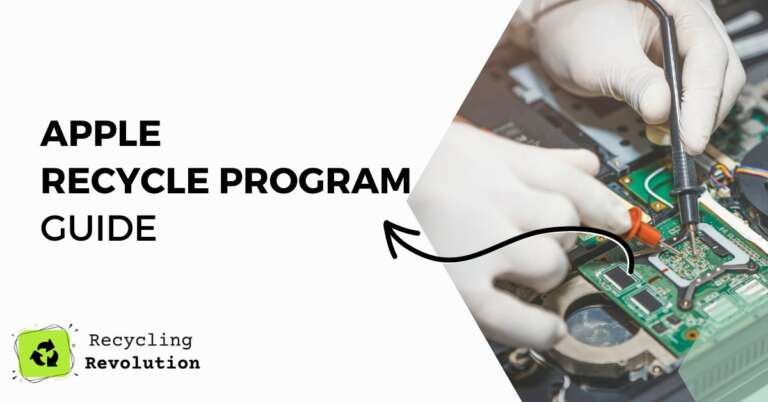In our evolving digital age, sustainability and environmental responsibility are rapidly becoming cornerstones of modern business ethos. A trailblazer in this aspect is Apple Inc. The technology giant has made significant strides in incorporating eco-friendly practices within its operations. A key initiative worth delving into is the Apple Recycling Program or commonly referred to the Apple Take Back Program.
This comprehensive program is a stellar demonstration of how corporations can actively mitigate their environmental impact while also providing valuable services to consumers.
TL;DR The Apple Recycling Program is an innovative initiative that allows consumers to recycle their Apple devices responsibly, often with the incentive of store credits. Through this program, Apple promotes the use of recycled materials in their products, thus minimizing electronic waste and reducing the need for mining raw materials. The success of the program is rooted in Apple’s commitment to a closed-loop supply chain and the utilization of high-tech recycling methods such as their proprietary robot, ‘Daisy’.
Here is a snapshot on how effective the Apple Take Back program has been
| Environmental Impact | Facts and Statistics |
|---|---|
| Material Recovery | Apple has recovered over 15,000 metric tons of materials from recycled devices since 2015. These materials include aluminum, steel, cobalt, copper, gold, silver, and rare earth elements. |
| Reduction in Mining | By integrating recycled materials into new products, Apple has reduced the need for mining raw materials. For example, the use of recycled tin in the logic boards of iPhone 12 models alone has prevented the mining of over 29,000 metric tons of tin ore. |
| Energy Efficiency | Apple’s recycling facilities and data centers are powered by 100% renewable energy, minimizing the carbon footprint associated with the recycling process. |
| Closed-Loop Supply Chain | Apple’s closed-loop supply chain approach focuses on using recycled materials in new product manufacturing. This reduces the demand for virgin resources and promotes a more sustainable product lifecycle. |
| Carbon Emissions Reduction | The use of recycled materials in Apple products has contributed to a significant reduction in carbon emissions. In 2020, Apple estimated that the use of recycled materials instead of virgin materials helped avoid approximately 4.3 million metric tons of CO2 emissions. |
Apple Recycling Program: Understanding the Essentials
Apple’s Recycling Program is multifaceted, designed to facilitate the easy return of Apple devices at the end of their life cycle. The objectives are twofold – to ensure the proper disposal of electronic waste and to encourage the recycling of materials for use in new devices. Here’s how it works:
- Trade-in and Recycling: Apple users can trade-in their eligible devices at Apple Stores or online. In return, they may receive an Apple Store gift card if the device has residual value. If not, Apple will recycle the device for free.
- AppleCare+ and Recycling: When customers buy an Apple device with AppleCare+, they have an opportunity to return their current device, which then enters Apple’s recycling process.
- Business and Education Recycling: Apple provides recycling options for businesses and educational institutions, facilitating the recycling of large quantities of Apple products.
- Recycling in Regions: Depending on regional laws and the availability of recycling facilities, Apple may offer additional recycling programs, such as battery replacement and recycling.
Being Eligible
To be eligible for Apple’s TakeBack Program, simply possess an Apple device, functioning or not. Trade-in eligibility for a store credit or gift card depends on the device’s model and condition. Even if there’s no trade-in value, Apple will recycle it responsibly at no cost to you.
Here is what devices are eligible
| Device Type | Trade-in Value | Recycled for Free |
|---|---|---|
| iPhone | Yes (if eligible) | Yes |
| iPad | Yes (if eligible) | Yes |
| Mac | Yes (if eligible) | Yes |
| Apple Watch | Yes (if eligible) | Yes |
| Apple TV | No | Yes |
| iPod | No | Yes |
| HomePod | No | Yes |
| Non-Apple devices (e.g., smartphones) | Sometimes (varies by region) | Sometimes (varies by region) |
Note: All devices are accepted for free recycling, but only eligible models in good condition can be traded in for a credit or gift card. The acceptance of non-Apple devices and their eligibility for trade-in may vary depending on the region
Tips on How to Prepare for Device Recycling
When preparing to recycle your Apple device through the Apple Recycling Program, it is crucial to take certain steps to protect your personal data and ensure a smooth recycling process. Here are some essential tips to consider:
- Backup Your Data: Before recycling your device, make sure to back up any important data or files. You can use iCloud, iTunes, or other cloud storage services to create a backup. This ensures that you won’t lose any valuable information during the recycling process.
- Sign Out from All Accounts: It is important to sign out of all accounts associated with your device, including iCloud, iTunes, App Store, and any third-party apps. This helps to protect your privacy and prevents unauthorized access to your accounts or personal information.
- Disable Activation Lock: If you have enabled Activation Lock (Find My iPhone/iPad/Mac) on your device, be sure to turn it off before recycling. This allows the new owner to set up and use the device without any issues.
- Perform a Factory Reset: To remove all personal data and settings from your device, perform a factory reset. This restores the device to its original state and erases all content. You can find the reset option in the device’s settings menu.
The Environmental Impact of the Apple Recycling Program
Apple’s commitment to environmental sustainability extends beyond its recycling program. The company actively measures and shares the quantifiable impact of its recycling efforts. Here are some key environmental impact statistics associated with the Apple Recycling Program:
- Material Recovery: Through the program, Apple has recovered millions of pounds of materials from recycled devices. These materials include aluminum, copper, gold, silver, cobalt, and rare earth elements.
- Reduction in Mining: Apple’s recycling efforts have significantly reduced the need for mining new materials. For example, the company’s use of recycled tin in logic boards for newer devices has prevented the mining of thousands of tons of tin ore.
- Renewable Energy: Apple powers its recycling facilities and data centers with 100% renewable energy, minimizing the carbon footprint associated with the recycling process.
- Closed-Loop Supply Chain: By integrating recycled materials into new products, Apple is reducing the demand for virgin resources and fostering a closed-loop supply chain. This sustainable approach decreases the environmental impact of the entire product lifecycle.
The Apple Recycling Program showcases the positive environmental outcomes achievable through responsible recycling practices and the circular economy model.
A Comparison with Other Tech Companies’ Recycling Initiatives
While Apple’s Recycling Program is notable, it’s worth examining how it compares to recycling initiatives by other tech giants. Here’s a brief comparison:
- Samsung: Samsung offers a similar trade-in program for their devices, allowing users to receive credits towards new purchases. They also have an e-waste recycling program, but the details and availability vary by region.
- Google: Google has partnered with various organizations to provide recycling options for their devices, including smartphones and Chromebooks. They also have trade-in programs in select countries.
- Microsoft: Microsoft offers a device trade-in program, allowing users to trade in eligible devices for store credit. They also have recycling initiatives in place, including responsible disposal of electronic waste.
While each company has its own approach to recycling, Apple stands out with its closed-loop supply chain and its commitment to using recycled materials in new product manufacturing.
Future Plans and Improvements to the Apple Recycling Program
Apple is continuously working to enhance its recycling program and contribute to a more sustainable future. Here are some future plans and improvements that Apple has announced:
- Expansion of Recycling Programs: Apple aims to expand its recycling initiatives to more countries, ensuring broader access to responsible recycling options for its customers worldwide.
- Innovations in Recycling Technologies: The company continues to invest in research and development of new recycling technologies. These advancements enable more efficient and precise material recovery from recycled devices.
- Increased Use of Recycled Materials: Apple plans to increase the use of recycled materials in its products. The company has set ambitious goals to reduce its reliance on virgin resources and move towards a more circular economy.
- Education and Awareness: Apple remains committed to educating its customers about responsible recycling and the importance of environmental sustainability. The company aims to raise awareness and encourage more individuals to participate in recycling programs.
By implementing these future plans and improvements, Apple demonstrates its ongoing dedication to minimizing electronic waste and maximizing the reuse of valuable resources.
In conclusion, Apple’s Recycling Program sets a high standard in the tech industry for responsible e-waste management. The program not only offers a convenient and rewarding way for customers to recycle their devices but also makes significant contributions to reducing the environmental impact of electronic waste.
By following the tips for device preparation, understanding the environmental impact, comparing initiatives with other tech companies, and staying informed about future plans, individuals can actively participate in this commendable recycling program and contribute to a greener and more sustainable future.
The Closed-Loop Supply Chain
At the heart of the Apple Recycling Program lies the vision for a closed-loop supply chain. Apple aims to cease the mining of new materials by reusing and recycling materials from returned devices. A significant portion of recycled materials, including tin, cobalt, and rare earth elements, are already used in new Apple products.
This approach not only reduces environmental impact but also decreases the reliance on rare and potentially conflict-associated raw materials.
Meet ‘Daisy’: Apple’s High-Tech Recycling Robot
Apple’s commitment to recycling extends to their innovative technologies. ‘Daisy’, Apple’s proprietary disassembly robot, is capable of dismantling 200 iPhones per hour.
Daisy retrieves valuable components and materials with a precision that surpasses manual disassembly, thus increasing the efficiency and yield of the recycling process.
Alternatives and Overlooked Aspects of Apple’s Recycling Program
While the Apple Recycling Program is commendable, it is also essential to consider alternatives and commonly overlooked aspects. Independent recycling centers, for instance, can be an excellent resource for non-Apple devices. However, ensure these centers follow environmentally sound practices.
On the flip side, while the Apple Recycling Program accepts all Apple devices, it’s worth noting that not all devices are eligible for credit. Older models or devices in poor condition may not have trade-in value but can still be recycled for free.
Conclusion
As an experienced observer of tech industry trends, I laud the strides made by Apple’s Recycling Program. It is not merely a corporate responsibility initiative but a strategic move that links customer service, environmental sustainability, and supply chain management. This program is an encouraging sign of how future-focused companies can lead in creating a greener, more sustainable world.
FAQ
Is the Apple Recycling Program available worldwide?
Yes, the Apple Recycling Program is available in many countries around the world, though specific services may vary depending on regional regulations and facilities.
What happens to my data when I recycle my device?
Before you hand over your device, Apple encourages you to back up your data and then perform a factory reset to erase all personal information.
Can non-Apple electronic devices be recycled through Apple’s Program?
Apple’s recycling program is primarily for Apple devices. However, Apple does accept mobile phones from other manufacturers in some regions.

